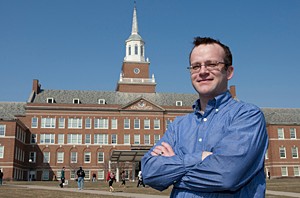
UC Researcher Examines Spatial Sermon Offered by the Creation Museum
A new article published by a University of Cincinnati communication researcher explores how brick and mortar can communicate messages that cut to the soul. The examination highlighting Kentuckys Creation Museum is published this month in the journal, Rhetoric and Public Affairs.
The essay by John Lynch, a UC associate professor of communication, is an analysis citing scholars of religion and philosophy into what Lynch calls the rhetoric of conversion.
Located in Petersburg, Ky., the $27 million, 70,000 square-foot Creation Museum was founded by Answers in Genesis, a biblical apologetics ministry. The museum promotes that its walk through history has the features of a modern natural history museum, but counters the theory of evolution that is communicated by those institutions.
Instead, Lynch describes the museum as an experiential landscape offering a spatial sermon that utilizes movement and visual cues to guide visitors along the path of religious conversion.
The Creation Museum is a spatial sermon where visitors learn the correct subject position to take toward the Bible, the creation story and evolution, as they move through the museum space, states Lynch. Intellectual concerns about cosmology and biology are transformed into a personal choice between two dichotomous views of the world: one based in the Bible and the other based solely in human reason.
Lynch says museums especially history museums are meant to give audiences a point of view on the past and on why we need to care about that particular part of our past. The environment is constructed by how you get from point-A to point-B. I think the Creation Museum is very much like that as well. Visitors are grounded by the story of the Bible from the moment they get in line and start moving through.
Lynch adds that unlike other natural history and science museums which give visitors multiple options of moving through the exhibits, the Creation Museum holds no alternatives, but rather moves visitors through the twisting path of human reason when it is bereft of faith to the brightly lit, straight path that is Young Earth Creationism.
Although the implied audience of the conversion narrative is the unconverted individual, the conversion narrative serves social and rhetorical functions for those who already believe, as well as those searching for the truth, writes Lynch.
Museums, explain Lynch, hold a threefold rhetorical structure, in that first, they hold multi-layered texts that consider placement of artifacts, art, multimedia, etc.
Secondly, Lynch states that in addition to the physical location and landscape where a museum is located, the facilities must inhabit a historical and cultural landscape, including a set of associations and images that visitors bring as they visit the museum. Third, states Lynch, museums shape identity and perception.
While not all visitors will assume the identity offered they will not all become converts or might already be converted the implied subject position for visitors throughout the site is that of a seeker a potential convert and the response of visitors to the museum and its claims about creationism and evolution will be formed in reaction to the identity they are offered, writes Lynch.
Lynch's teaching and research interests focus on the rhetoric of science and medicine, especially on how the public understands science.
Published by Michigan State University Press, Rhetoric and Public Affairs is an interdisciplinary journal devoted to the history, theory and criticism of public discourse. The high-profile journal is one of the mainstay journals for humanities-inspired science communication.
Related Stories
Ancient Maya blessed their ballcourts
April 26, 2024
Using environmental DNA analysis, researchers identified a collection of plants used in ceremonial rituals in the ancient Maya city of Yaxnohcah. The plants, known for their religious associations and medicinal properties, were discovered beneath a plaza floor upon which a ballcourt was built, suggesting the building might have been blessed or consecrated during construction.
OTR mural centerpiece of 'big' celebration of UC alumni
April 26, 2024
New downtown artwork salutes 18 alumni award recipients who personify UC’s alumni success.
From literature to AI: UC grad shares career path to success
April 23, 2024
Before Katie Trauth Taylor worked with international organizations like NASA, Boeing and Hershey, and before receiving accolades for her work in the generative AI space, she was in a much different industry: English and literature.
